Assassination of Jesse James
Published by Misha Mazor on January 12th, 2014
NIGHTEXT



Lighting for the scene was provided mostly by a 5K Par mounted on the front of the train and specially rigged lanterns held by the actors. We also had some gag lights underneath the train — little bare bulbs dimmed down — to light the steam and create the effect of this fiery red glow beneath the train. We had a special-effects rig on the train that would create sparks as it started braking. I’d positioned some lights on Condors to rake through the trees so you’d get some sense of the trees before the train came. But about an hour before we started shooting, I decided to turn them off, and instead we just pumped some atmosphere into the area. Luckily there wasn’t much of a wind, so we could maintain a low level of smoke hanging in the air and just let the light on the front of the train provide the general ambience.

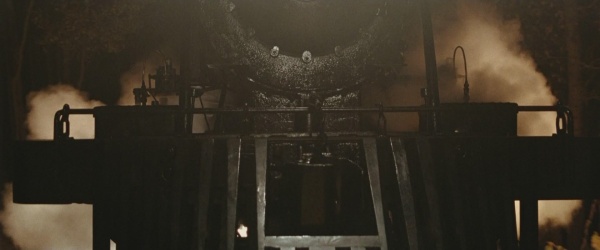
we set up a camera-platform rig with a big, soft buffer, and the train actually hit the platform and started pushing it along. In that particular shot, you can really see the warm glow of the bulbs underneath the engine. We also positioned a little silver reflector that caught some of the bounce from the 5K on the train, just to create some reflected light that would reveal the front of the train — otherwise, there was nothing else to illuminate it.
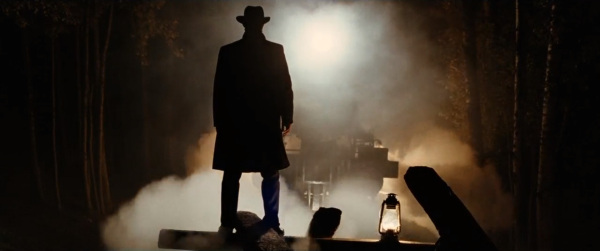
We had a steam generator on the train so that when it stopped, we got this big cloud of steam that Jesse disappears into.

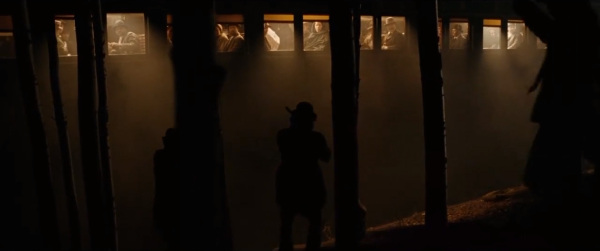

The only time we used conventional film lights in that sequence was when we were running with the outlaws down the hill toward the train. The robbers are supposed to look as if they’re being lit by the light at the front of the train, and I think we used a 10K bounced off a white card to create that sort of effect amid the steam. When we finally show the train carriage, you can see the passengers amid this golden light coming through the windows. That light was provided by 175-watt mushroom bulbs mounted on 10-foot strips positioned all the way down the interior ceiling of the train carriage. We could rely on our dummy lanterns when we were inside the train, but when we shot that exterior we had to really project the light out into the atmosphere. That shot of the passengers was inspired by one of Andrew’s photographic references, and I think it’s one of the most successful shots in the film. When we were doing it, though, it filled me with dread, because I was concerned that the light would just burn out the passengers and it would end up looking silly.
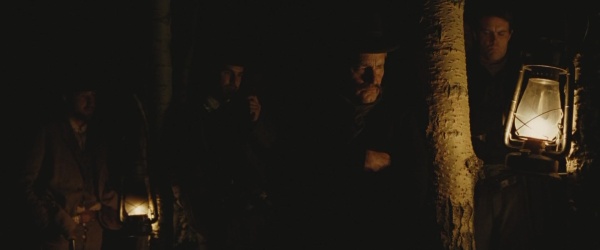
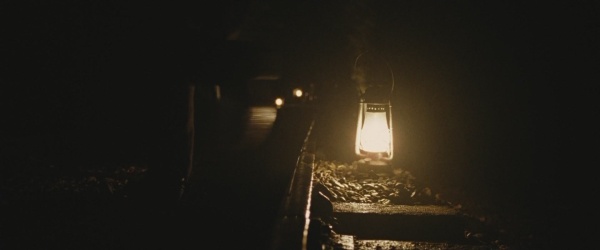

Jesse James: The lanterns were dummied with 300- or 500-watt bulbs. Sometimes I’d keep the flame and put the bulbs behind the flame, dimmed way down. We positioned little pieces of foil between the bulb and the flame so all the camera would see was the little flame. At other times during the robbery, we just had bulbs in the lanterns — two bulbs side by side, dimmed down and sometimes flickering very gently. All the lanterns I used were powered with a cable which on two shots was removed digitally. I have always had a problem with using batteries as I like to have the use of a flicker generator and a dimmer. I judge the flicker by eye as flicker generators have a way of changing on their own accord! To augment the lanterns for close-up shots, I occasionally used a warmed-up Tweenie bounced off a gold stippled reflector.
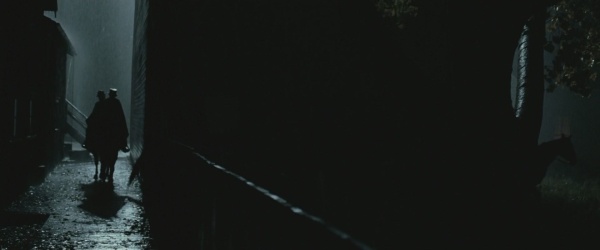
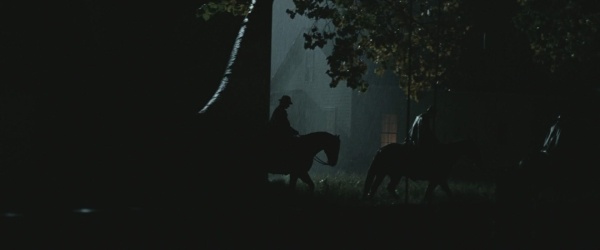

That night scene in the rain was lit from two lifts with 2 x 10Ks and 2 x 5Ks on each. My lighting diagram has 8 x 10Ks total but I remember scaling that down a little. I often ask for more than I end up using! Each lamp had 1/2 blue and quite a bit of wire as I didn't need the amount of light that that firepower gave me but I wanted the spread. I shot at 2.0 I remember. There was no light source on the riders other than from the lifts and if Andrew had asked to see the riders faces I would have put a practical up on the wall somewhere. I think we did talk about that but I rejected it because I liked seeing the warm light in the window of Jesse's house and not before.
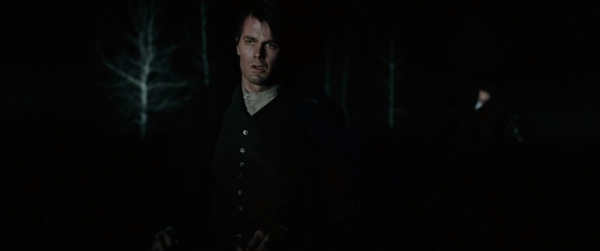
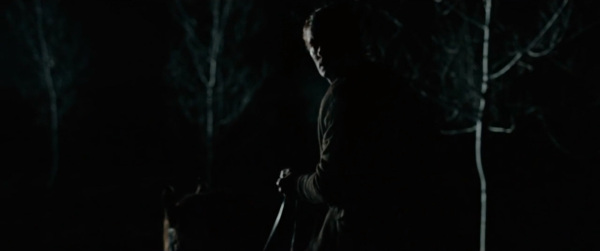
For the death of Ed Miller we placed some 9 X 10Ks (gelled 1/2 Blue) in a horizontal line on a hill in front of the riders set back some 300' [400'] from the action. They were about 200' away and between them and the riders we constructed a long black 'bottomed'. I suppose moonlight would be the justification for that source. I wanted the characters to be floating in blackness and so this 'bottomer' served to cut the light off the ground. The 10Ks gave me a somewhat soft wrap horizontally but I could still cut the ground. In order to get the feeling of movement at all in this inky blackness I had some white saplings dug in along the route the riders were taking. That was about it really except to say that I did need to help bring some detail into the black horses during the DI as they were a little down compared to the faces. If you’re trying to track a man on a horse for 200 feet, he’ll get brighter and brighter as he approaches the light unless the source is a mile away, and that just wasn’t feasible. But in the DI, I could compensate. Of course, it is simpler to use one or two large sources, such as the Muscos we used for 'No Country...', but I don't find the effect so pleasing as it never seems to translate well in close shots.
Andrew wanted them to be riding black horses, but I told him that was going to be really tough at night. In that type of situation, you don’t want to see too much of the landscape, so I basically lit up these little white trees to provide some sense of the background. Andrew really just wanted to show the characters as disembodied heads floating in blackness, but I knew it would be really hard to hold those details with the characters moving over a long distance. Andrew wanted a very particular, silvery look for night scenes, so it wasn’t realistic in that sense. (ACM Oct 2007)
[Another post, but not 100% sure if its about this scene]: we used a row of something like 14 x 10Ks, spaced at about 5' intervals, to light a horse track of about 300' in length. The lamps were placed at about 200' from the nearest point to the set, which was a balance to give the least falloff over the whole space whilst achieving enough exposure. Even so I was shooting at a 2.0 at 500ASA on Cooke S4s.
NIGHTINT

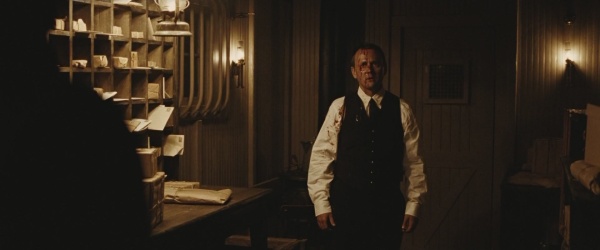
Inside the train, all the oil lamps had little tin hats on top of them; inside those were pieces of silver foil and a ring of five 250–300 watt bulbs dimmed down [to 40%] with flicker generators. Those read really well onscreen, but if you looked closely at the actual lamp it wouldn’t make sense, because the light was coming from the tin hat and not from the lamp itself. I chose those in collaboration with the art department because I knew Andrew wanted to do a constant move through the train with Frank James

I lit that scene with 1Ks, and I removed the lenses from the lamps to create a really sharp, pinpoint source. When you put that kind of source through a window, you’ll get the pattern of the glass on the background. Old glass has a kind of wavy texture.
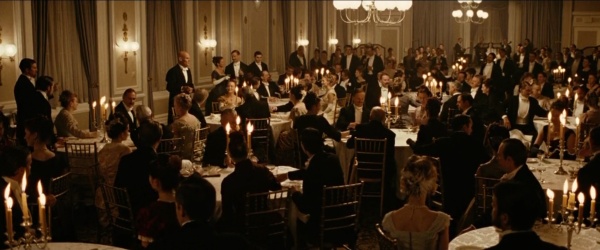

The colour of those reference shots was all done in camera without using gels but by dimming the sources.
Ballroom scene lit with lightweight ring-light rigs that I could hang from the ceiling. Those are basically concentric rings of household bulbs controlled by a dimmer. I hung the larger one over the governor’s table; that rig had a 10-foot ring of about 20 40-watt bulbs; an 8-foot ring with 60-watt bulbs; a 6-foot ring of 75-watt bulbs; and an inner ring with 100-watt bulbs" Everything was back to a dimmer and run at about 40% to give a warmth to the light. The colour temperature was then set at around 2600K. Something like that. The ceiling was very low so I needed the frame height. There was no skirt and no diffusion. It just wasn't needed with such a large soft source. Sometimes when I light like this I will have the inner rings progressively lower to create a 'chandelier' but I didn't have the height in this particular instance. The rest of the lighting for that scene was provided by the little globe lights you see above the tables. For close-ups, I might’ve bounced a light off a piece of card.


Most of the lighting for the stage was generated by bare bulbs serving as footlights and some Tweenies rigged from the stage rail above.. The footlights were probably just 150-watt bare bulbs.
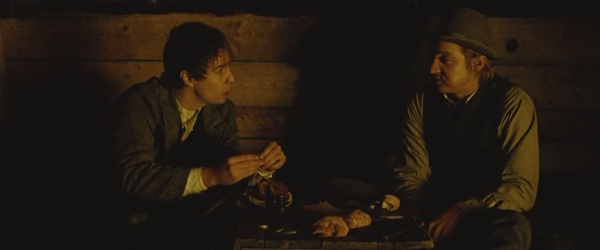
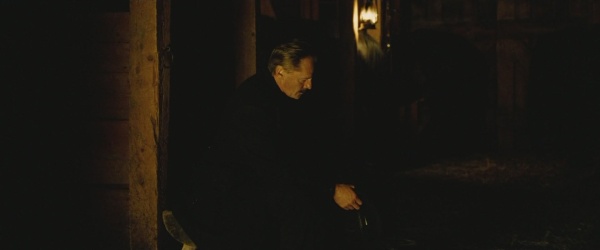

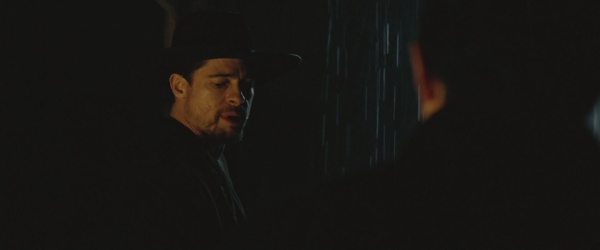
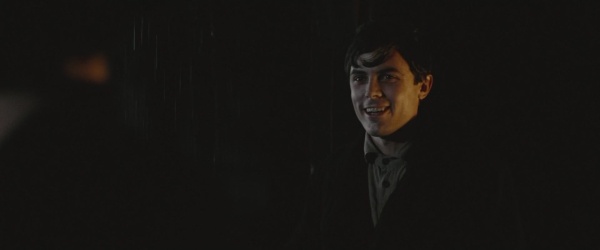
The sequence in and outside the barn was lit using Tweenies and Gold Stipple bounce material. The lights were warmed further with 1/2 CTO gel and flicker generators created some flicker. The background and rain was backlit using a 5K with 1/2 Blue gel. i used a separate light to edge the characters which also lit the foreground rain.
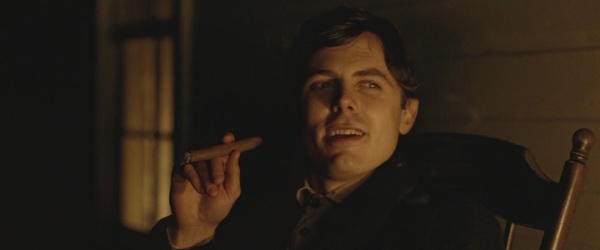

lit by the lamp itself but that was really a 200 watt halogen bulb dimmed down to something like 40%. The were other lights used on the shot but the 'oil' lamp was lighting the faces.



Lit by the above-the-table practical, which had two 1K bulbs in it and was wrapped with diffusion for the closer shots. The bulbs were dimmed way down.
DAYINT
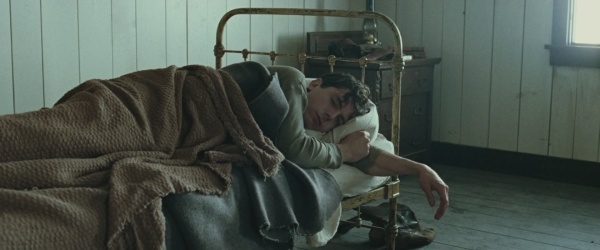
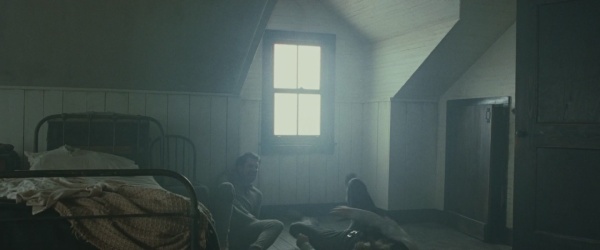
Scenes set in this house had to be shot in a studio, which led Deakins to blow out the windows. We had big circular panels of diffusion outside every window and aimed a group of 2K Blondes at each window from about 20 feet away.

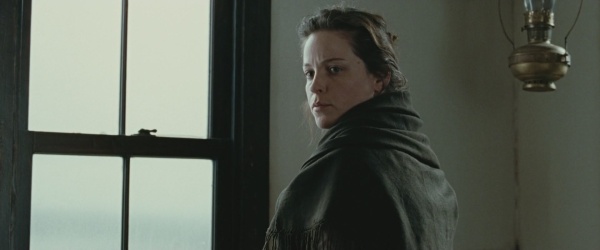
When we were downstairs in our studio house, I tried to create a feeling of the landscape and the snow outside the windows by positioning black flags slightly beyond the windows and keeping them out of focus to create the line of a hill (similar horizon line flags for Jahead). There’s not a lot you can do in those kinds of situations. The blown-out windows ended up being part of the look of the film, because I did that even on some of our location sets.
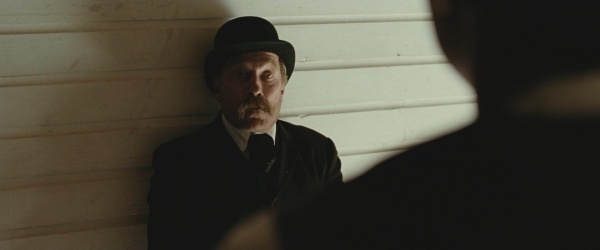
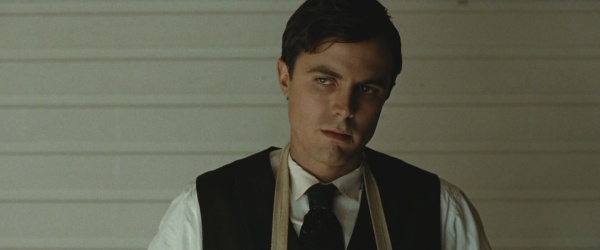
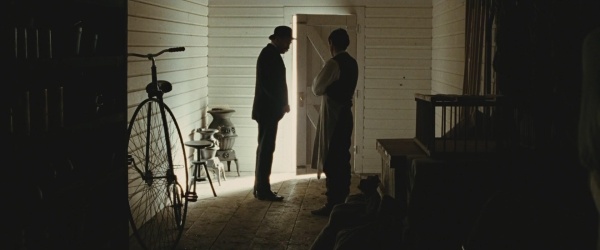
We got the light in the storeroom just by blasting an 18K HMI at the narrow opening of the door and flagging the top of the light. The lamp was a little high and angled down. and there was a 1/4 grid between the lamp and the exterior of the door. It was also about 8 or 10 feet from the door [20 feet in another post]. Quite close really! I remember we were shooting at 2.5 on 500 ASA stock and I think I used an 85 on the camera instead of correcting the lamp, but I may be wrong about this. We shot the scene after dark so it was all artificial light. The art director had always intended to paint the room a light tone so that worked for me. The closer shots were done in much the same lighting set up. I think I softened it a little with very light diffusion over the doorway. Some of the close shots of Casey were actually done at a later time, as the director wanted a different performance, and I had to match the original set up.
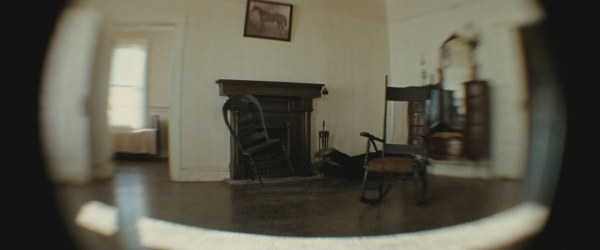
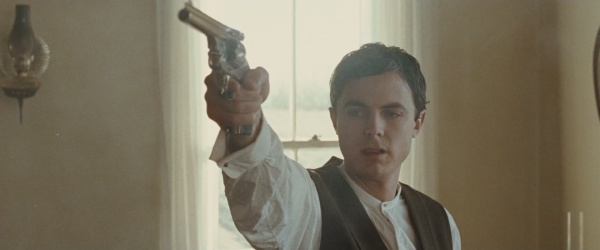
 scene in which Robert shoots Jesse: The scene takes place in a house that was built on location and for that reason much of what I was doing was controlling the natural light. We were after a sunny bucolic feel to the scene. Through the windows I was bouncing natural sunlight or 18K HMIs off 12' x 12' Ultrabounce reflectors. Inside I bounced some 400 watt Jokers off muslin material which was mounted on 4' x 4' frames or just taped to the wall. I also used an 18K HMI hard to mimic sunlight although some of the 'sunlit' shots, especially from after the shooting, were shot taking advantage of natural sunlight. For these shots I used just a little interior bounce from the floor in addition to the natural light.
scene in which Robert shoots Jesse: The scene takes place in a house that was built on location and for that reason much of what I was doing was controlling the natural light. We were after a sunny bucolic feel to the scene. Through the windows I was bouncing natural sunlight or 18K HMIs off 12' x 12' Ultrabounce reflectors. Inside I bounced some 400 watt Jokers off muslin material which was mounted on 4' x 4' frames or just taped to the wall. I also used an 18K HMI hard to mimic sunlight although some of the 'sunlit' shots, especially from after the shooting, were shot taking advantage of natural sunlight. For these shots I used just a little interior bounce from the floor in addition to the natural light.As I say, the room was part of a house built on location and weather played a big part in forcing us to schedule shots around the daylight. Some close shots were actually made after dark and lit using artificial sources.


on location and I had 4K HMIs bouncing through the windows.
DAYEXT

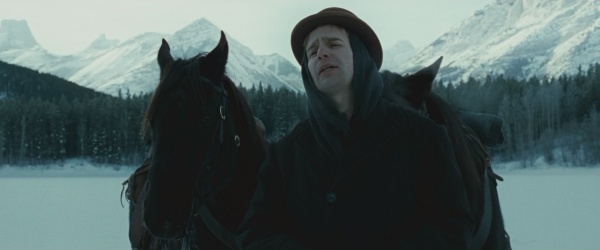
The scene on the ice was shot very cleanly with no filtration other than an 85. I also used no additional light at all. I really didn't have the time to light the scene even if I had wanted to, as it was December and the day was very short. We were very lucky in that the sun was so low it never reached the surface of the frozen lake, which at least gave us a very consistent light. In the DI I brought down the lake and the characters with a selective matte that ran through the trees. We wanted the feeling that the lake was in a cool shadow whilst the mountains were in the sunlight. I was never worried about the exposure of the scene as the light was very soft. Even the mountain tops were not as bright in reality as they appear in the film.
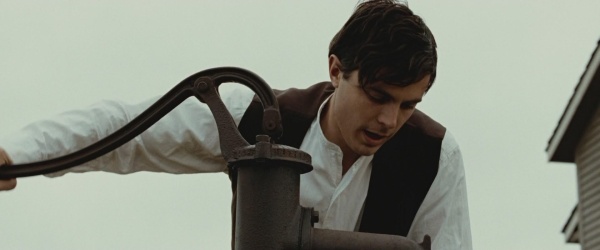
we used a 90 degree shutter to give an uncomfortable feeling to the images which I think worked quite well.
CAMERAtag
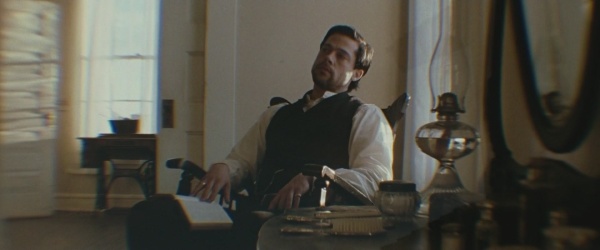
That was done entirely in camera with lenses that are now called ‘Deakinizers.’ I used to use this gag where I put a small lens element in front of a 50mm to get a similar effect. I went to Otto Nemenz and asked how we could create that effect in a better way, with more flexibility and lens length. The lens technician suggested taking the front element off a 9.8 Kinoptic, and also mounting the glass from old wide-angle lenses to the front of a couple of Arri Macros. Otto now rents out three Deakinizers. Removing the front element makes the lens faster, and it also gives you this wonderful vignetting and slight color diffraction around the edges. We used different lenses, so some were more extreme or slightly longer than others. Sometimes we used [Kardan] Shift & Tilt lenses to get a similar effect. (Deakins)
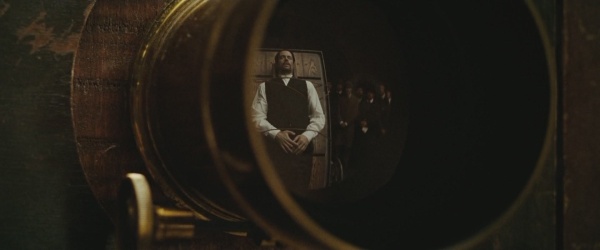
The shot of Jesse's body reflected in the lens of the box camera was done, as you suggested, just by lighting the body with a sharp and bright light. This shot was something I saw as we were shooting the wide shot of the scene and the hardest thing about it was keeping focus, given there was a slight track in, and keeping the camera out of the reflection.
More stills from the film:
Source: